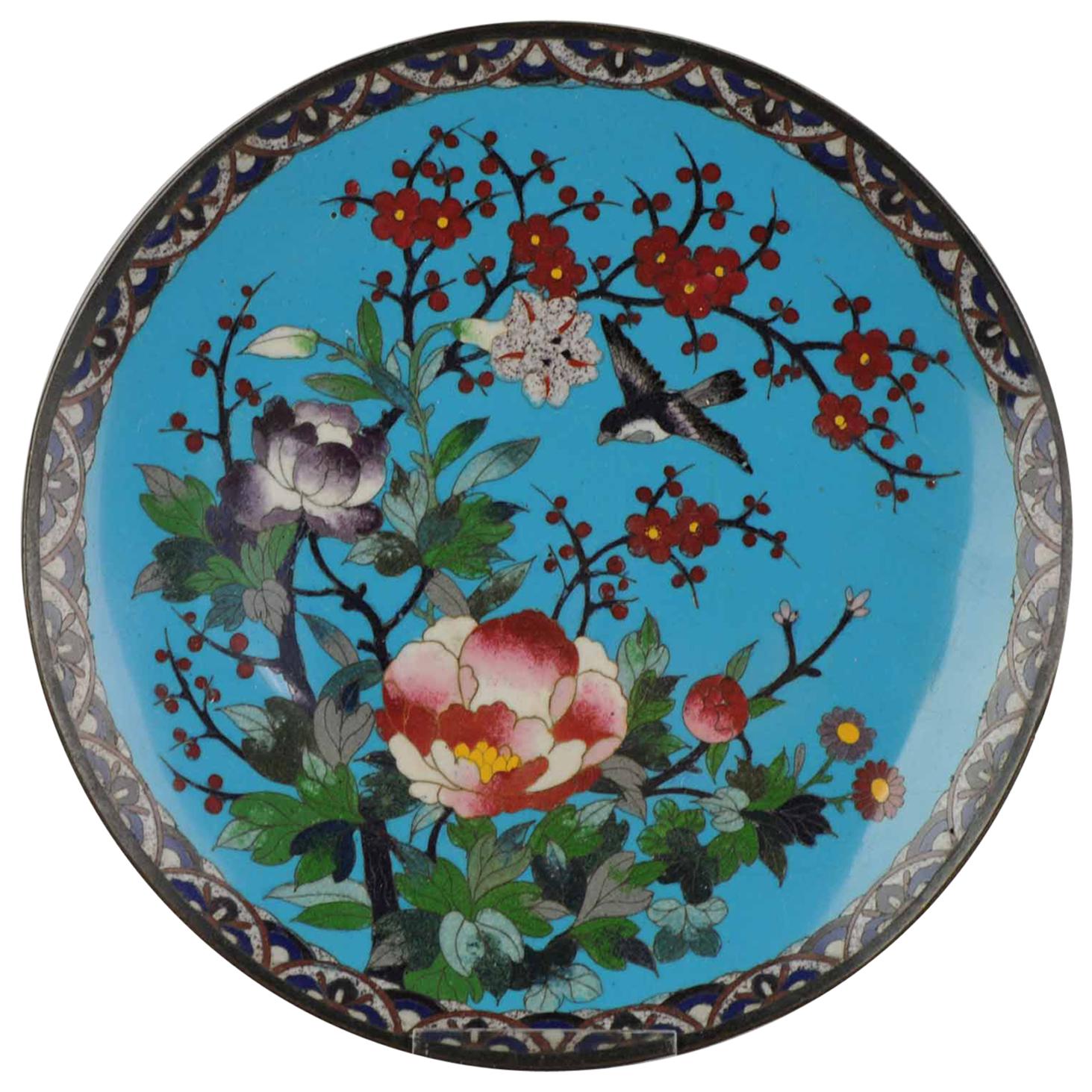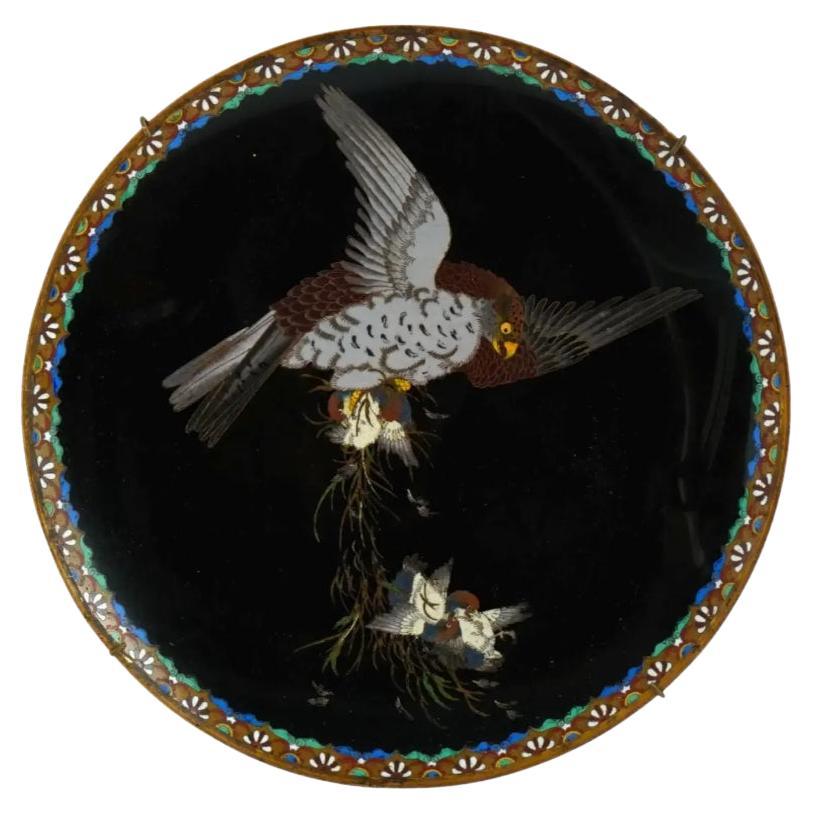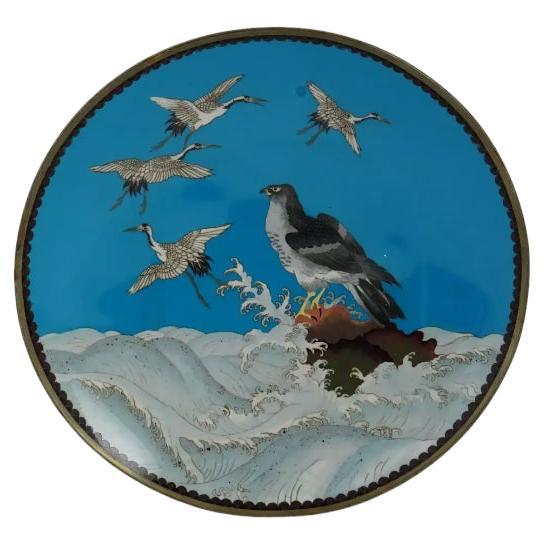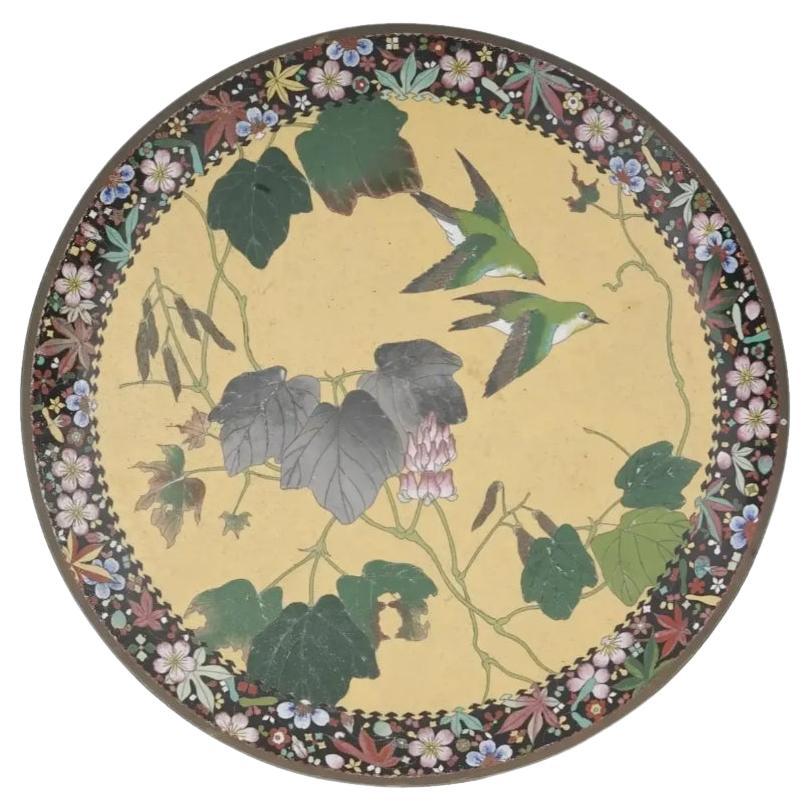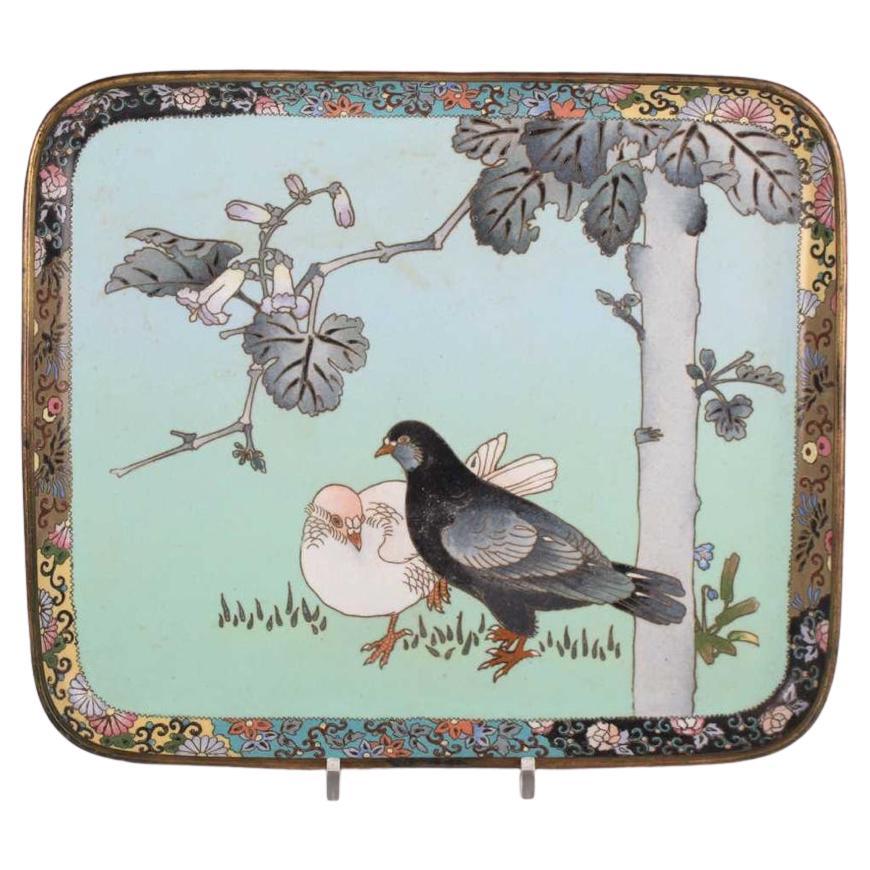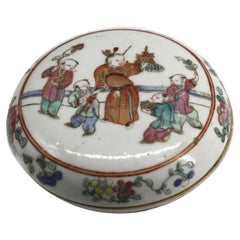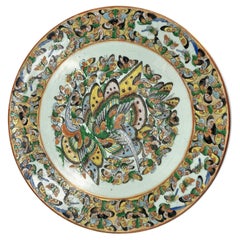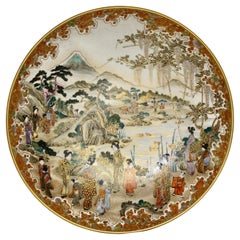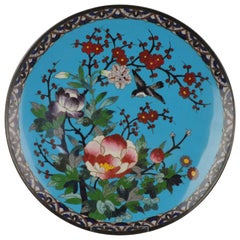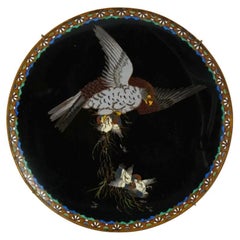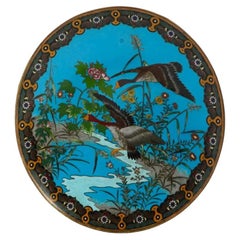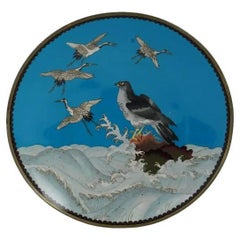Items Similar to A Cloisonné Dish Meiji period (1868-1912)
Want more images or videos?
Request additional images or videos from the seller
1 of 7
A Cloisonné Dish Meiji period (1868-1912)
$1,800
£1,376.20
€1,585.10
CA$2,522.35
A$2,815.97
CHF 1,475.53
MX$34,470.22
NOK 18,739.19
SEK 17,668.67
DKK 11,829.76
Shipping
Retrieving quote...The 1stDibs Promise:
Authenticity Guarantee,
Money-Back Guarantee,
24-Hour Cancellation
About the Item
A Cloisonne Dish
Meiji period (1868-1912)
decorated with a lively Falcon reserved on a light pink ground
diameter 11 3/4 inches
- Dimensions:Height: 2.5 in (6.35 cm)Diameter: 11.75 in (29.85 cm)
- Materials and Techniques:
- Period:
- Date of Manufacture:20th Century
- Condition:Wear consistent with age and use.
- Seller Location:West Palm Beach, FL
- Reference Number:1stDibs: LU3860135142342
About the Seller
5.0
Vetted Professional Seller
Every seller passes strict standards for authenticity and reliability
Established in 1989
1stDibs seller since 2018
114 sales on 1stDibs
Typical response time: 10 hours
- ShippingRetrieving quote...Shipping from: West Palm Beach , FL
- Return Policy
Authenticity Guarantee
In the unlikely event there’s an issue with an item’s authenticity, contact us within 1 year for a full refund. DetailsMoney-Back Guarantee
If your item is not as described, is damaged in transit, or does not arrive, contact us within 7 days for a full refund. Details24-Hour Cancellation
You have a 24-hour grace period in which to reconsider your purchase, with no questions asked.Vetted Professional Sellers
Our world-class sellers must adhere to strict standards for service and quality, maintaining the integrity of our listings.Price-Match Guarantee
If you find that a seller listed the same item for a lower price elsewhere, we’ll match it.Trusted Global Delivery
Our best-in-class carrier network provides specialized shipping options worldwide, including custom delivery.More From This Seller
View AllChinese Cloisonne Enamel Vase
Located in West Palm Beach, FL
Chinese Cloisonne Enamel Vase.
The tapered vessel with a long neck and circular spreading foot, decorated allover with colorful blossoms on a sky-blue ground.
Height 6.5 in., Diamet...
Category
20th Century Antiquities
Materials
Enamel
Chinese Famille Rose Rose Medallion Porcelain Platter
Located in West Palm Beach, FL
Chinese Famille Rose Rose Medallion Porcelain Platter Late 19th/early 20th Century.The circular platter with a raised foot is decorated with allover butterflies.
Diameter 14.75 in.
...
Category
20th Century Ceramics
Materials
Ceramic
An Earthenware Dish By Kinkozan, Meiji period, late 19th century
By Kinkozan
Located in West Palm Beach, FL
An earthenware dish
By Kinkozan, Meiji period, late 19th century
Painted in polychrome enamels and gilt over a clear crackled glaze with beauties and children enjoying a summer outing in a mountainous water landscape, the scene surrounded by a frame of blossoming flower heads,
signed in gilt Kinkozan zo...
Category
Antique 19th Century Antiquities
Materials
Ceramic
Chinese Cloisonne Enamel Vase
Located in West Palm Beach, FL
Chinese Cloisonne Enamel Vase
The spherical body with a long cylindrical neck, on a raised circular foot, decorated with cranes and foliage on a green ground.
Height 15.5 in. Diamet...
Category
20th Century Antiquities
Materials
Enamel
Japanese Cloisonne Vase and Cover, Meiji Period
Located in West Palm Beach, FL
A Japanese Cloisonne vase and cover, Meiji period
finely decorated in silver and copper wire and a variety of coloured enamels with six panels, the body and cover with bands of lapp...
Category
20th Century Ceramics
Materials
Copper
Japanese Satsuma Earthenware Circular Box and Cover
Located in West Palm Beach, FL
A Japanese Satsuma earthenware circular box and cover
decorated in enamels and gilt with cover showing birds and trees reserved on foliate scrolls on a m...
Category
20th Century International Style Antiquities
Materials
Ceramic
You May Also Like
Lovely Antique Meiji Japanese Bronze Cloisonné Serving Plate Bird, Japan
Located in Amsterdam, Noord Holland
Lovely and very detailed piece.
Condition:
Overall condition, some age signs at the base and also a small chip. Front very good, only some crackle lines. Size: 240 mm
Period:
Mei...
Category
Antique 19th Century Japanese Meiji Ceramics
Materials
Bronze
$661 Sale Price
20% Off
Rare Antique Meiji Japanese Cloisonne Charger Plate
Located in Long Island City, NY
A rare antique Japanese Meiji era, enamel over copper charger plate. The exterior of the plate is adorned with a polychrome scene with an eagle and nestlings on black ground made in ...
Category
Antique Late 19th Century Japanese Meiji Metalwork
Materials
Enamel, Copper
Antique Japanese Meiji Era Cloisonne Enamel Plate Goto
Located in Long Island City, NY
An antique Japanese, probably Goto school, enamel over copper charger plate.
The exterior of the plate is adorned with a polychrome image of ducks flying over a pond with blossomin...
Category
Antique Late 19th Century Japanese Metalwork
Materials
Copper, Enamel
Antique Japanese Meiji Era Cloisonne Enamel Plate
Located in Long Island City, NY
An antique Japanese Meiji era enamel over copper charger plate. The exterior of the plate is adorned with a polychrome scene with an eagle standing on a rock and cranes flying over w...
Category
Antique Late 19th Century Japanese Meiji Metalwork
Materials
Copper, Enamel
$1,250 Sale Price
50% Off
Large Antique Japanese Meiji Cloisonne Plate 1900
Located in Long Island City, NY
A large antique Japanese Meiji period cloisonne enamel metal charger plate depicting a multicolored picture of two birds hovering over graceful acacia branches on a pale yellow ground. Features a highly detailed polychrome border depicting cherry blossoms and red maple leaves and other floral motifs on a black ground. The backside is adorned with a swirl wavy motif made in the cloisonne technique and has a border decorated with stylized geometric patterns. Circa the late 19th or early 20th century. Antique Japanese Plates...
Category
Antique Late 19th Century Japanese Meiji Tableware
Materials
Enamel
$2,450 Sale Price
30% Off
A Fine Japanese Meiji Period Cloisonné Enamel Tray Attributed to Namikawa Sösuke
Located in London, GB
A Japanese Meiji Period Cloisonné Enamel
Tray Attributed to Namikawa Sösuke, Late 19th Century
A refined rectangular cloisonné enamel tray with softly rounded corners and shallow...
Category
Antique 19th Century Japanese Metalwork
Materials
Enamel
More Ways To Browse
Meiji Period
1868 Furniture
20th Century Cloisonne
Vintage Cloisonne
Vintage Pink Dish
Chinese Export Butterfly
Chinese Plate Kangxi
Qing Dynasty Imperial
Asian Coins
Chinese Celadon Ceramics
Ming Plate
Antique Chinese Miniature
Imari Charger
Satsuma Hand Painted
Japanese Meiji Bowl
Imari Lidded Jars
Rose Medallion Porcelain
Japanese Imari Jar Lid
